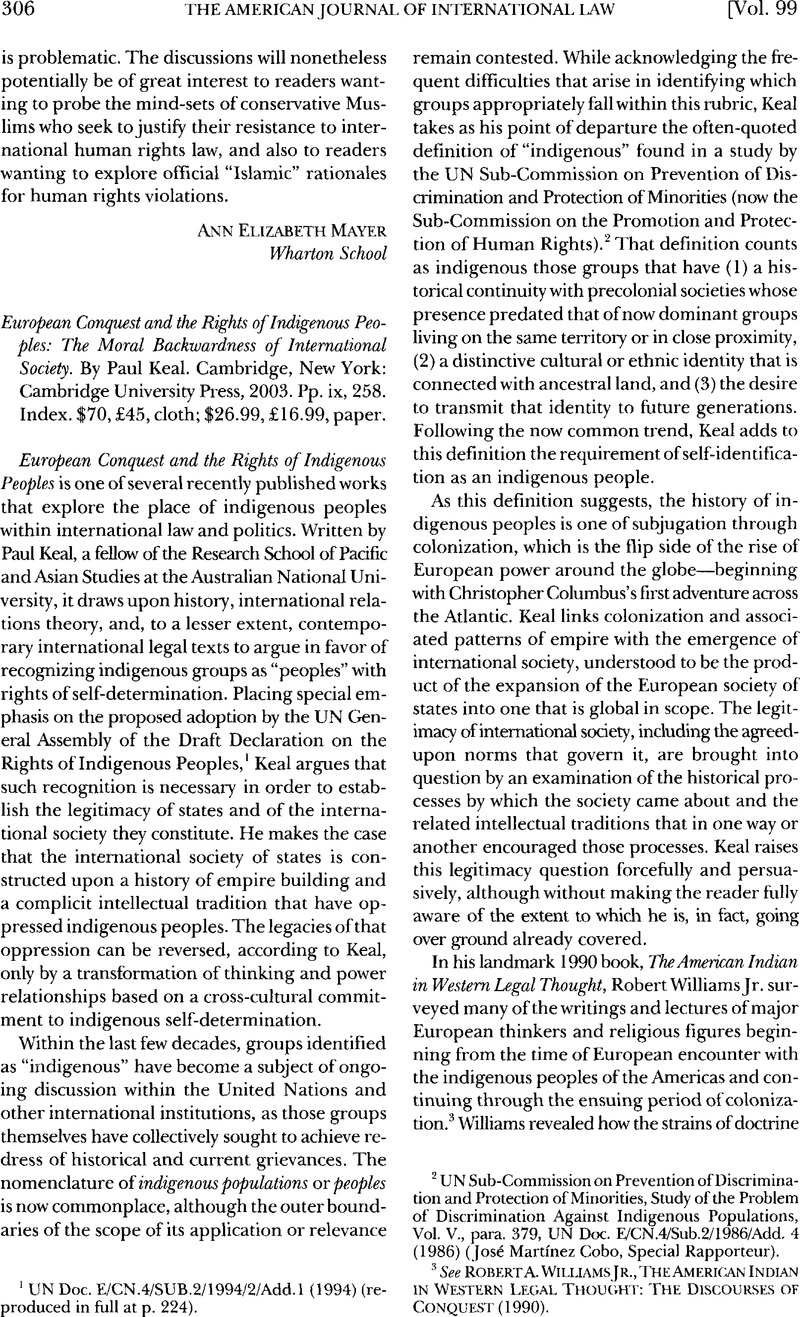Article contents
European Conquest and the Rights of Indigenous Peoples: The Moral Backwardness of International Society. By Paul Keal. Cambridge, New York: Cambridge University Press, 2003. Pp. ix, 258. Index. $70, £45, cloth; $26.99, £16.99, paper.
Published online by Cambridge University Press: 27 February 2017
Abstract

- Type
- Recent Books on International Law
- Information
- Copyright
- Copyright © American Society of International Law 2005
References
1 UN Doc. E/CN.4/SUB.2/1994/2/Add.l (1994) (reproduced in full at p. 224).
2 UN Sub-Commission on Prevention of Discrimination and Protection of Minorities, Study of the Problem of Discrimination Against Indigenous Populations, Vol. V., para. 379, UN Doc. E/CN.4/Sub.2/1986/Add. 4 (1986) (José Martínez Cobo, Special Rapporteur).
3 See Robert, A. Williams Jr., The American Indian in Western Legal Thought: the Discourses of Conquest (1990)Google Scholar.
4 See, e.g., James, E. Falkowski, Indian Law/Race Law: A Five-Hundred-Year History (1992); Patrick Thornberry, Indigenous Peoples and Human Rights 61–88 (2002)Google Scholar; Anaya, S.James , Indigenous Peoples in International Law 9–37(1996)Google Scholar.
5 Cf. Paolo, G. Carozza, From Conquest to Constitutions: Retrieving a Latin American Tradition of the Idea of Human Rights, 25 Hum. Rts. Q. 281,289–96 (2003)Google Scholar (a flattering portrayal of the sixteenth-century Spanish Dominican priest Bartolomé de las Casas and his writings on the Indians of the Americas, without any attention to the cultural biases in that writing as revealed by Keal and others).
6 See THORNBERRY, supra note 4, at 72-74; ANAYA, supra note 4, at 26-31.
7 Mayagna (Sumo) Awas Tingni Community v. Nicaragua, Inter-Am. Ct. H.R. (Ser. C) No. 79 (2001).
8 See, e.g., Dann v. United States, Case No. 11.140, Report No. 75/02 (Inter-Am. C.H.R. Dec. 27, 2002) (finding that the United States violated the due process and property rights of Western Shoshone people by inadequately addressing Western Shoshone claims to ancestral lands); Maya Indigenous Communities v. Belize, Case No. 12.053, Report No. 40/04 (Inter-Am. C.H.R. Oct. 12, 2004) (finding that Belize violated the property rights of Maya communities by granting concessions for logging and oil development on Maya traditional lands and by failing to recognize Maya rights in those lands under domestic law).
9 These and other international developments concerning indigenous peoples are summarized in Anaya, S. James , International Human Rights and Indigenous Peoples: The Move Toward the Multicultural State, 21 Ariz. J. Int’l & Comp. L. 13 (2004)Google Scholar, and are analyzed more extensively in Anaya, S. James , Indigenous Peoples in International Law (2d ed. 2004)Google Scholar.
10 Convention (No. 169) Concerning Indigenous and Tribal Peoples in Independent Countries, June 27, 1989, preambular para. 5 (entered into force Sept. 5, 1991), at <http://www.ilo.org>.
11 See generally Donna Lee, Van Cott, The Friendly Liquidation of the Past: The Politics of Identity in Latin America (2000)Google Scholar (including a discussion of the role of Convention No. 169 in the indigenous rights movement).
- 2
- Cited by




